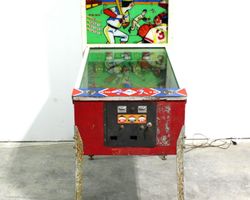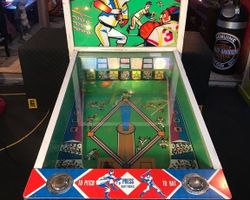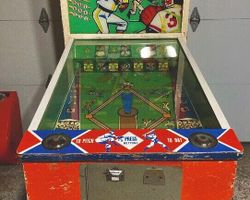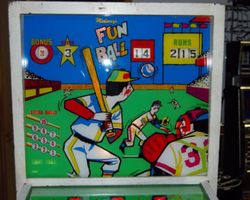Fun Ball

Average Prices: USD $300 to $1,400
Produced: December, 1966
Machine Type: Electro-mechanical
Players: 1
Midway Manufacturing Company, a name that evokes a significant chapter in arcade and amusement history, released "Fun Ball" in December 1966. This electro-mechanical (EM) pinball machine was designed for a single player and stood out with its unique designation as a "Bat Game." The theme was unambiguously baseball, a universally appealing sport that lent itself well to the competitive spirit of pinball. Midway, already a prominent player in the coin-op industry, often sought to innovate within the confines of EM technology, and "Fun Ball" represented one such effort to integrate a novel mechanical playfield element into a familiar theme.
The design and production process for EM machines like "Fun Ball" typically involved a collaborative effort. While individual designers and artists were not always prominently credited on flyers or within the machine itself, the creation of "Fun Ball" would have been the result of engineers, cabinet makers, and artists working in concert. The team focused on translating the essence of baseball into a compelling pinball experience. This meant not just static artwork, but dynamic playfield features that mimicked the action of the sport. "Fun Ball" was offered in three configurations: Regular, Replay, and Extended Play models. This adaptability allowed operators to tailor the machine to their specific location's needs, whether focusing on pure play, awarding free games, or extending game time. An interesting historical note reveals that some Replay models had their replay windows covered by operators, likely adapting them for non-replay venues, sometimes even adding a cabinet button for game starts. This detail underscores the practical considerations of machine deployment in the mid-1960s.
Signature Features and Design
"Fun Ball" distinguishes itself through its innovative application of the "Bat Game" concept, a pivotal element that elevates the baseball theme beyond mere aesthetics. The machine's core appeal lies in its integration of a physical batting mechanism. This feature, likely positioned in a strategic location on the playfield, allows players to directly interact with the ball in a manner reminiscent of a baseball player hitting a pitch. Unlike static targets or passive rollovers, the "bat" mechanism provides a tactile, engaging experience, where precise timing and skill could influence the ball's trajectory and subsequent scoring opportunities.
Beyond the titular bat, "Fun Ball" would have incorporated various other mechanical toys and targets that tied into the baseball motif. These might include pop bumpers representing outfielders, drop targets for bases, or spinners mimicking a pitcher's mound. The design philosophy aimed to enhance the overall experience by transforming the pinball playfield into a miniature baseball diamond. The artwork on the backglass and playfield would have depicted lively baseball scenes, complete with players, dugouts, and cheering crowds, all rendered in the vibrant, illustrative style typical of 1960s EM machines. The cohesive visual and mechanical design of "Fun Ball" ensured that every element contributed to the immersive baseball narrative, making the act of playing feel like stepping onto the diamond.
Playfield and Mechanics
The playfield of "Fun Ball" is meticulously laid out to emulate a baseball field, guiding the player through a progression of shots that simulate the flow of a game. At the heart of the playfield, the "bat" mechanism serves as a primary interactive element. Players would aim to strike the ball with this mechanism, attempting to send it towards various targets representing hits, bases, or even home runs. The success of these "at-bats" dictates the progression of the game.
Major shots on the playfield would likely include a series of drop targets or stand-up targets representing bases (First, Second, Third), which illuminate as they are hit, indicating a runner on base. Rollover lanes might represent a single, double, or triple, advancing "runners" around the diamond. Perhaps a central ramp or loop shot could symbolize a deep fly ball or even a home run, offering substantial points and advancing all runners. The flow of the playfield would encourage strategic play, where players aim for specific targets to advance their "runners" and ultimately score. For example, hitting a series of targets in sequence might constitute a "inning" or a successful scoring drive.
The artwork on the playfield and backglass is integral to the machine's aesthetic, featuring classic 1960s sports illustrations. Bright, primary colors would define the playing surface, highlighting key scoring areas and paths. Lighting elements would further enhance the baseball theme, illuminating bases as they're earned, or flashing lights to signify a score. The overall aesthetic would be one of playful competition, designed to evoke the excitement and energy of a baseball game, thereby contributing significantly to player immersion.
Gameplay Dynamics
"Fun Ball" employs a gameplay dynamic centered around the objective of scoring "runs" by advancing "runners" around the baseball-themed playfield. The scoring system is directly tied to this progression, rewarding players for making "hits" and bringing "runners" home. Unique modes or objectives likely revolve around completing a specific sequence of shots or activating certain targets to simulate a baseball inning. For instance, players might need to hit a "single" (activating one target), then a "double" (activating another), to move their virtual runners around the bases.
One of the standout aspects of "Fun Ball's" gameplay is its provision for "several ways to win a free play." This indicates a well-designed replay system, typical of EM machines seeking to maximize engagement and operator revenue. These free play opportunities could be awarded through achieving specific high scores, completing designated bonus objectives (such as hitting a "grand slam" by advancing all bases in one sequence), or reaching certain numerical score thresholds. This multi-faceted approach to awarding free games encourages extended play and repeat attempts, adding a layer of strategic depth beyond simply accumulating points. Players might focus on specific in-game objectives that they know lead to a free game, rather than just aiming for the highest score. For example, successfully advancing all three bases and then hitting a "home run" shot might be a prime target for a replay award. The "Bat Game" mechanic itself introduces a layer of player skill, as precise timing of the "bat" can open up pathways to higher scoring opportunities or specific bonus targets, making each game a test of both luck and dexterity.
Reception and Legacy
"Fun Ball" garnered a highly positive reception among its players and operators, a sentiment that endures among collectors who have experienced the machine. The prevailing feedback highlights the machine's core strength: its sheer "fun factor." The name "FUN BALL" was consistently deemed "most appropriate," underscoring the immediate and enduring enjoyment it provided. A significant aspect of its positive reception was its mechanical reliability. Reviewers and owners frequently noted the machine was "mechanically very sound" and remained "trouble-free for many years" even with subsequent owners. This mechanical robustness was a critical factor for operators, minimizing downtime and maintenance, and it contributes to the machine's appeal as a durable and dependable piece of pinball history. The inclusion of "several ways to win a free play" was also a strong point, enhancing replayability and keeping players engaged by offering tangible rewards beyond mere score accumulation. The primary "weakness," if it can be called that, is the regret expressed by those who parted with their "Fun Ball" machines, indicating a lasting positive impression and a desire to revisit the experience.
The legacy of "Fun Ball" is rooted in its effectiveness as an engaging EM pinball machine with a clear, universally understood theme. It stands as an example of successful thematic integration in EM design, demonstrating how a simple yet effective mechanical feature like the "Bat Game" could elevate gameplay. While not a machine that introduced entirely new paradigms to pinball design, its influence lies in solidifying the appeal of sports-themed tables and showcasing the potential for direct player interaction with unique playfield mechanisms beyond flippers and bumpers. Its reputation in the pinball community is that of a reliable, enjoyable, and well-designed EM, cherished for its straightforward fun and robust construction, embodying the essence of 1960s pinball entertainment.
Sponsored Links
 Ebay Listings
Ebay Listings
 Auction Results
Auction Results
| Cost | Location | Date |
|---|---|---|
| USD $580 |  Wisconsin, United States Wisconsin, United States |
06 March, 2024 |
| CAD $2,250 |  Canada Canada |
13 November, 2022 |
| USD $400 |  Maryland, United States Maryland, United States |
16 September, 2021 |
| USD $1,400 |  North Carolina, United States North Carolina, United States |
03 November, 2020 |
| USD $260 |  Illinois, United States Illinois, United States |
12 November, 2015 |
| USD $450 |  California, United States California, United States |
01 September, 2013 |
| USD $550 |  Michigan, United States Michigan, United States |
20 January, 2008 |


Private Policy · Search Website · Contact Us
As an eBay Partner, we may earn a commission from qualifying purchases made through links on this site, at no additional cost to you.
All trademarks and copyrighted materials remain property of their respective owners. All other content copyright 2007 - 2025 Pinpedia.





